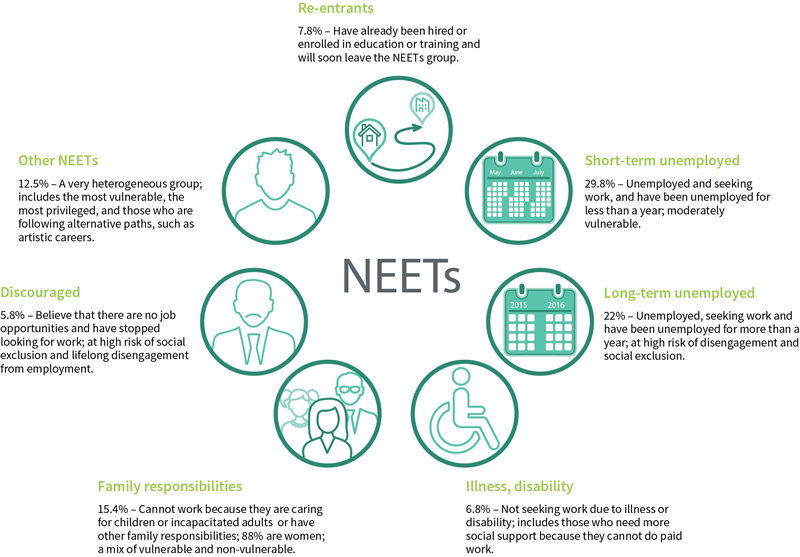EU context
Pojem se od leta 2010 široko uporablja kot kazalnik za zagotavljanje informacij za politike, osredotočene na mlade, o zaposljivosti, izobraževanju, usposabljanju in tudi socialni vključenosti v državah članicah EU-28.
Izraz NEET je bil prvič izrecno omenjen v razpravah o evropski politiki v vodilni pobudi strategije Evropa 2020 „Mladi in mobilnost“. Starostna skupina, zajeta s tem izrazom, je bila 15–24 let, pozneje pa je bila razširjena, tako da vključuje mlade, stare od 15 do 29 let. Pojem je zdaj vključen v vse razprave o politiki na ravni EU. Trenutno 14,2 % prebivalstva v starosti od 15 do 29 let predstavlja populacija NEET.
Aprila 2013 je bil sprejet predlog Evropske komisije Svetu Evropske unije za izvajanje jamstva za mlade v vseh državah članicah. Zmanjšanje populacije NEET je izrecni cilj politike jamstva za mlade. Cilj te pobude je zagotoviti, da vsi mladi v starosti od 15 do 24 let v štirih mesecih po začetku brezposelnosti ali zaključku formalnega izobraževanja prejmejo kakovostno ponudbo za zaposlitev, nadaljnje izobraževanje, vajeništvo ali pripravništvo. Postopno uvajanje jamstva za mlade v državah članicah prek pobude za zaposlovanje mladih je prispevalo k izboljšanju dejanskega stanja, tj. zmanjšanju števila mladih, ki niso zaposleni, se ne izobražujejo ali usposabljajo.
Nedavno, tj. 7. decembra 2016, je Evropska komisija začela izvajati pobudo Vlaganje v mlade v Evropi, ki pomeni obnovljena prizadevanja za podpiranje mladih. Glede na dosedanji pozitiven učinek jamstva za mlade namerava Komisija povečati in razširiti finančna sredstva, ki so na voljo za spodbujanje zaposlovanja mladih do leta 2020 za spodbujanje učinkovitejšega vključevanja mladih.
Delo Eurofounda
Z izvajanjem jamstva za mlade se je populacija NEET v starosti od 15 do 29 let nekoliko zmanjšala, in sicer s približno 14 milijonov na vrhuncu krize na 12,5 milijona leta 2016 (14,2 %). Vendar ocene Eurofoundove raziskave kažejo veliko izgubo za evropska gospodarstva v višini približno 142 milijard EUR na leto (2015) zaradi izplačanih socialnih prejemkov ter izpada dohodkov in davkov. To znatno vpliva na gospodarski in družbeni razvoj EU.
Ključni prispevki
Eurofound je doslej odigral pionirsko vlogo na področju obsežnih raziskav o populaciji NEET (glej publikacije, navedene v nadaljevanju) in:
- izvedel prvo primerjalno analizo na ravni EU o populaciji NEET;
- pojasnil, kdo spada v populacijo NEET;
- ocenil ekonomske stroške populacije NEET;
- proučil družbene posledice pripadnosti populaciji NEET;
- ocenil dejavnike tveganja, da se mladi znajdejo v kategoriji NEET;
- proučil učinkovitost politik za ponovno vključevanje pripadnikov populacije NEET;
- spremljal izvajanje jamstva za mlade.
Raznolikost populacije NEET:
V okviru te raziskave je poskušal Eurofound razkriti raznolikost znotraj populacije NEET. Najnovejša študija o raznolikosti populacije NEET zagotavlja novo kategorizacijo v sedem podskupin za boljše razumevanje sestave te skupine mladih. Cilj je zagotoviti ustreznejšo pomoč oblikovalcem politike pri razumevanju, kdo spada v populacijo NEET, in pomagati pri načrtovanju ustreznih podpornih ukrepov za izpolnitev različnih potreb. Vsaka od teh skupin je sestavljena iz kombinacije ranljivih in neranljivih mladih, ki ne kopičijo človeškega kapitala prek formalnih kanalov, bodisi prostovoljno ali neprostovoljno.

Druge raziskovalne teme
Poleg navedene študije je Eurofound v zadnjih letih raziskal (glej publikacije, navedene v nadaljevanju):
- značilnosti in koristi podjetništva mladih;
- načine vključevanja „manjkajoče sredine“: mladih s srednješolsko izobrazbo, ki ne nadaljujejo izobraževanja na visokošolski ravni;
- socialno vključenost mladih;
- prehod mladih na trg dela;
- povečevanje začasnega zaposlovanja med mladimi in dostop do socialne zaščite;
- delovne razmere mladih, ki vstopajo na trg dela, in
- najnovejši razvoj politike, povezan s populacijo NEET.
Glej seznam publikacij v nadaljevanju.
Publikacija: Raziskovanje raznolikosti populacije NEET
4. julij 2016 – V tem poročilu je na podlagi poročila Eurofounda iz leta 2012 z naslovom Skupine NEET – Mladi, ki niso zaposleni, se ne izobražujejo ali usposabljajo: značilnosti, stroški in odzivi politike v Evropi proučenih sedem podskupin, na katere je mogoče razdeliti populacijo NEET, pri čemer so bili uporabljeni podatki , pridobljeni iz raziskave o delovni sili v EU iz leta 2013. Te podskupine omogočajo izboljšano analizo vpliva politik, socialnega okolja in počasnega, vendar postopnega izboljševanja trga dela na populacijo NEET v EU-28. Pomagajo pri ugotavljanju, kaj je mogoče storiti za obravnavanje vprašanj, kadar, na primer, dolgotrajno brezposelni predstavljajo 22 % populacije NEET v starosti od 15 do 24 let. Na voljo je tudi 28 profilov držav o raznolikosti populacije NEET, ki prikazujejo trenutno stanje populacije NEET na ravni držav članic. V njih so proučeni trendi brezposelnosti mladih in število NEET, sestava skupine NEET ter tveganja za njihovo socialno izključenost.
Raziskovanje raznolikosti populacije NEET
NEETs infographic (Informativna grafika populacije NEET)














